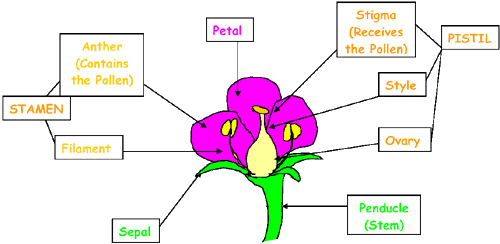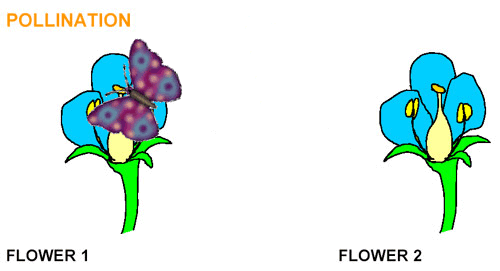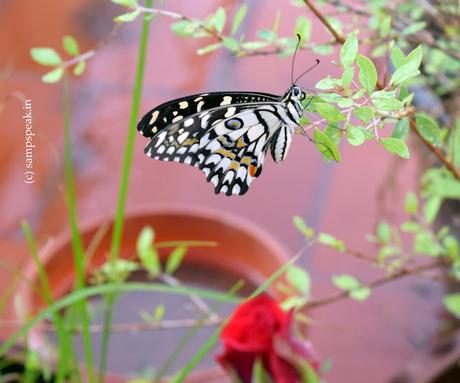Pollination is important for a strong, healthy ecosystem. One in three bites of food you eat depends on pollinators. The list is long - Apples, Almonds, Oranges, Avocados, Peaches, Pears, Plums, Cherries, Alfalfa, Blueberries, Vanilla, Cranberries, Tomatoes, Kiwi, Figs, Coffee, Strawberries, Blackberries, Raspberries, Lemons, Limes, Eggplants, Kumquats, Nectarines, Grapes, Cacao .. .. … and more.
Pollination involves processes at multiple spatial scales (pollen moving short distances within a plant vs long-distance transport between plants via a vector) and often involves an interaction between an animal and a flower. This means that pollination needs to be considered within the physical, environmental, and biotic context in which it takes place, which has led to the rise of the field of pollination ecology. Pollination is just one step in the reproductive cycle of plants, albeit a critical one. Pollination is the act of transferring pollen grains from the male anther of a flower to the female stigma. The goal of every living organism, including plants, is to create offspring for the next generation. One of the ways that plants can produce offspring is by making seeds. Seeds contain the genetic information to produce a new plant.

Flowers are the tools that plants use to make their seeds. Seeds can only be produced when pollen is transferred between flowers of the same species. A species is defined a population of individuals capable of interbreeding freely with one another but because of geographic, reproductive, or other barriers, they do not interbreed with members of other species. How does pollen get from one flower to another? Flowers must rely on vectors to move pollen. These vectors can include wind, water, birds, insects, butterflies, bats, and other animals that visit flowers. We call animals or insects that transfer pollen from plant to plant “pollinators”. Pollination is usually the unintended consequence of an animal’s activity on a flower. The pollinator is often eating or collecting pollen for its protein and other nutritional characteristics or it is sipping nectar from the flower when pollen grains attach themselves to the animal’s body. When the animal visits another flower for the same reason, pollen can fall off onto the flower’s stigma and may result in successful reproduction of the flower.

https://www.fs.fed.us/wildflowers/pollinators/What_is_Pollination/
The foregoing is general and collated from couple of web sources – this article in phys.org makes a very interesting read : A network of “insect superhighways” is set to be created across the UK to provide struggling pollinators with food and shelter as they travel through the landscape. The charity Buglife has drawn up plans for a network of so-called ‘B-lines’ that will criss-cross the country from Cornwall to the Shetland Islands, linking together the best wildlife habitats for insects. Studies suggest numbers of bees, moths and other pollinators are declining dramatically as a result of climate change, habitat loss and pollution.
A collapse in pollinator numbers could devastate global production of chocolate and Brazil nuts, a team of scientists led by the University of Cambridge warned. Populations of bees, butterflies, wasps and many other pollinators are shrinking because of climate change, habitat destruction and pesticide use. Their disappearance could send shockwaves through the global food system, the scientists warned, sparking a “crop pollination deficit” that would see agricultural yields fall. Crops such as cocoa and Brazil nuts that rely exclusively on wild pollinators would be among the hardest hit, according to lead author Dr Lynn Dicks from Cambridge’s Department of Zoology. And chocolate is feared to be among the most vulnerable because it is dependent on the biting midge Forcipomyia.
Disappearing habitats and use of pesticides are driving the loss of pollinator species around the world, posing a threat to "ecosystem services" that provide food and wellbeing to many millions—particularly in the Global South—as well as billions of dollars in crop productivity. This is according to an international panel of experts, led by the University of Cambridge, who used available evidence to create the first planetary risk index of the causes and effects of dramatic pollinator declines in six global regions. The bees, butterflies, wasps, beetles, bats, flies and hummingbirds that distribute pollen, vital for the reproduction of over 75% of food crops and flowering plants—including coffee, rapeseed and most fruits—are visibly diminishing the world over, yet little is known of the consequences for human populations.
"What happens to pollinators could have huge knock-on effects for humanity," said Dr. Lynn Dicks from Cambridge's Department of Zoology. "These small creatures play central roles in the world's ecosystems, including many that humans and other animals rely on for nutrition. If they go, we may be in serious trouble." Dicks assembled a 20-strong team of scientists and indigenous representatives to attempt an initial evaluation of the drivers and risks for pollinator declines worldwide. The research is published today in Nature Ecology & Evolution. The top three global causes of pollinator loss are habitat destruction, followed by land management—primarily the grazing, fertilizers and crop monoculture of farming—and then widespread pesticide use, according to the study. The effect of climate change comes in at number four, although data are limited.
Perhaps the biggest direct risk to humans across all regions is "crop pollination deficit": falls in quantity and quality of food and biofuel crops. Experts ranked the risk of crop yield "instability" as serious or high across two-thirds of the planet—from Africa to Latin America—where many rely directly on pollinated crops through small-holder farming. Pollinators have been sources of inspiration for art, music, literature and technology since the dawn of human history," said Dicks. "All the major world religions have sacred passages about bees. When tragedy struck Manchester in 2017, people reached for bees as a symbol of community strength."
"Pollinators are often the most immediate representatives of the natural world in our daily lives. These are the creatures that captivate us early in life. We notice and feel their loss. Where are the clouds of butterflies in the late summer garden, or the myriad moths fluttering in through open windows at night?" "We are in the midst of a species extinction crisis, but for many people that is intangible. Perhaps pollinators are the bellwether of mass extinction," said Dicks. Loss of access to "managed pollinators" such as industrial beehives was ranked as a high risk to North American society, where they boost crops including apples and almonds, and have suffered serious declines from disease and 'colony collapse disorder'. The impact of pollinator decline on wild plants and fruits was viewed a serious risk in Africa, Asia-Pacific and Latin America—regions with many low-income countries where rural populations rely on wild-growing foods. In fact, Latin America was viewed as the region with most to lose. Insect-pollinated crops such as cashew, soybean, coffee and cocoa are essential to regional food supply and international trade right across the continent. It is also home to large indigenous populations reliant on pollinated plants, with pollinator species such as hummingbirds embedded in oral culture and history. Asia Pacific was another global region where pollinator decline was perceived to pose serious risks to human well-being. China and India are increasingly reliant on fruit and vegetable crops that need pollinators, some of which now require people to pollinate by hand.

The researchers caution that not enough is known about the state of pollinator populations in the Global South, as evidence of decline is still primarily from wealthy regions such as Europe (where at least 37% of bee and 31% of butterfly species are in decline). Pollination deficits and biodiversity loss were seen as the biggest risks to Europeans, with potential to affect crops ranging from strawberries to oilseed rape. “If you don’t have pollination you don’t get any cocoa pods,” Dr Dicks told i. “So you really need pollination of cocoa and it’s delivered by these tiny midges.” The research team fears chocolate supplies could face serious reductions in as few as 20 to 50 years, but there is huge uncertainty because there have been so few studies of the midge. “No one has mastered the ability to breed these midges,” Dr Dicks added, warning that once wild pollination slumps there’s nothing humans can do to step in and mimic that process. Coupled with increasingly erratic weather and rainfall patterns as a result of climate change, pollinator loss is “the last thing people need”, Dr Dicks said. She stressed that beyond the impact on the food system, loss of pollinators could be devastating for local wild ecosystems.
The decline of pollinators in Europe is reasonably well documented in wealthy regions such as Europe, where at least 37 per cent of bee and 31 per cent of butterfly species are in decline. But less is known about the rates of decline in poorer nations, which leads to huge uncertainty over the pace and scale of potential impacts. The study – published in the journal Nature Ecology and Evolution – warns there is still “considerable scientific uncertainty” about what pollinator loss means for human society.
Interesting !
With regards – S. Sampathkumar27th Aug 2021.
Biblio : : https://phys.org/news/2021-08-pollinators-global-index-species-declines.html

